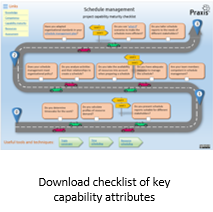- determine timescales for the work;
- calculate profiles of resource demand;
- present schedule reports suitable for different stakeholders.
| Indicators | Level 2 attributes |
Scheduling approaches are closely linked to scope complexity which means there is a wide range of ‘appropriate’ methods. As complexity increases, different modelling techniques may be required to match the needs of different sections of work. For example, programme scheduling will cover a greater breadth and focus on the consolidation and summarisation of multiple project and business change schedules. It is recognised that at level 2 the modelling and scheduling should be adequate but less sophisticated than it could be. It is also likely that scheduling focuses on the activity required to deliver outputs and may not apply the same rigour to management activities such as communication, risk response and procurement. At level 3 the organisation is expected to use approaches that are more than just adequate and introduce sophistication that reduces risk and increases shareholder satisfaction. The management activities involved in areas such as communication, risk responses and procurement should be modelled and scheduled with the same rigour as the production activities and integrated with them. Having built an accurate model of the schedule a level 3 organisation will use it to test alternative scenarios, not only to solve issues but also constantly refine the schedule. Stakeholders will be able to obtain up-to-date schedule information that is tailored to their requirements rather than relying on standard schedule reports. |
| Identify work | Work required to deliver objectives is identified and documented appropriately. This is updated regularly with a frequency that matches the scale and complexity of the work. | |
| Time scheduling | Single or multiple models are built that are adequate for the context and complexity of the work. These are periodically updated as the work is monitored and controlled. Time estimates are mainly subjective and only single point estimates are used. The model is analysed using methods adequate for the context and complexity of the work. Analyses are repeated to reflect progress. | |
| Resource scheduling | Resource estimates are mainly subjective and based on a general knowledge of the types of resource employed. The model is analysed using methods adequate for the context and complexity of the work. Analyses are repeated to reflect progress. | |
| Report | Standard reports are distributed at regular intervals. | |
| Indicators | Level 3 attributes | |
| Identify work | Activities required to manage functions are identified and included in the scheduling model. | |
| Time scheduling | Schedules are updated at regular, frequent intervals as the work is monitored and controlled. All technical and managerial activity is included in the models. Time estimates are based on objective data wherever possible. Analyses are repeated to reflect progress and test ‘what-if’ scenarios. | |
| Resource scheduling | Resource estimates are based on objective data wherever possible and on a specific knowledge of the resources employed. The influence of different resources on the schedule is understood. Analyses are repeated to reflect progress and test ‘what-if’ scenarios. | |
| Report | Stakeholders are regularly provided with schedule reports that are tailored to their differing needs. | |






